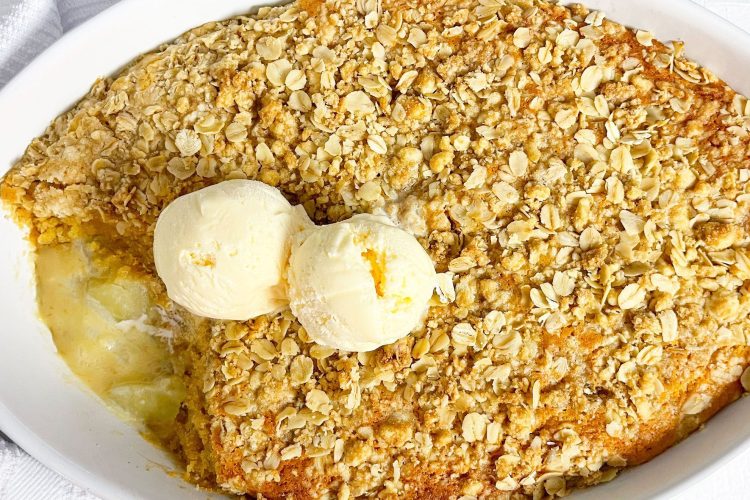The Ultimate Guide to Crumble: A Classic Dessert’s History, Variations, and Recipes

has made it a favorite in homes around the world. Traditionally associated with British cuisine, the crumble has evolved over the years, taking on different forms and incorporating various ingredients, while still holding onto its classic charm. In this article, we’ll delve into the history of crumble, its variations, and offer some delicious recipes that you can try at home.
Table of Contents
ToggleThe Origins of Crumble
Crumble as we know it today began to take shape in the UK during World War II. Due to food shortages and rationing, traditional pies, which required more flour, butter, and sugar, became a luxury that most people couldn’t afford. Bakers and home cooks turned to a simpler solution: crumble.
Crumble’s topping is made using a smaller quantity of butter, flour, and sugar, which is combined until it forms a crumb-like texture. This was then layered over seasonal fruits such as apples, blackberries, or rhubarb, and baked until golden brown. The resulting dessert was easy to make, inexpensive, and delicious, making it an instant hit.
Unlike pies, where pastry needed to be rolled out and fit into a tin, crumble could be thrown together in a bowl and spread over fruit, making it quicker and more accessible to the average home cook.
Over the years, the crumble became more than just a wartime necessity. As times improved and ingredients became more readily available, it transitioned from a practical dish into a staple of British comfort food.
What Makes a Good Crumble?
At its heart, a crumble is a marriage of two key components: the fruit base and the topping. While the concept seems simple, a great crumble is more than just throwing fruit and flour together—it requires balance, texture, and the right mix of flavors. Let’s break down the essential components of a crumble.
1. The Fruit Base:
The base of a crumble is typically made from seasonal fruits. Apples are the most common, but variations include berries, stone fruits like peaches or plums, or tart options like rhubarb. Ideally, the fruit should be slightly tart to balance the sweetness of the crumble topping.
One of the key aspects of the fruit base is the texture. While you want the fruit to be soft and juicy, it’s important not to overcook it to the point of mush. Many recipes suggest cooking the fruit slightly before baking it with the crumble topping, ensuring that it remains tender but not overly soft.
2. The Topping:
The topping is where crumble sets itself apart from other fruit-based desserts. A classic crumble topping consists of flour, sugar, and butter, rubbed together until they form small crumbs. This mixture is then spread over the fruit base and baked until golden brown.
Some variations include oats, nuts, or even spices like cinnamon or nutmeg, which add depth to the dessert’s flavor profile. The topping should have a buttery crunch that contrasts with the softness of the fruit beneath it.
The key to achieving the perfect topping lies in balancing the ingredients so that the topping is crisp, but not too heavy or greasy. You also want it to hold its crumbly texture even after baking, so that it provides a satisfying contrast to the soft fruit.
3. Texture and Flavor Balance:
The best crumbles offer a balance of textures and flavors. The contrast between the juicy, tart fruit and the buttery, crunchy topping is what makes crumble so special. A good crumble has depth of flavor, with the fruit providing both sweetness and acidity, and the topping offering richness and a little bit of savory warmth.
Popular Variations of Crumble
Crumble may have started as a humble dish, but it has since blossomed into a versatile dessert with endless variations. Each version brings its own unique flavors and textures to the table, making crumble a dessert that can be enjoyed in countless ways.
1. Apple Crumble:
The classic apple crumble is perhaps the most iconic of all. Made with tart cooking apples like Bramley or Granny Smith, this version balances the fruit’s sharpness with the sweetness of the crumble topping. Some recipes call for adding spices such as cinnamon or cloves to the apples, while others suggest a splash of lemon juice or orange zest for added complexity.
2. Rhubarb Crumble:
Rhubarb crumble is another British favorite, especially during the spring months when rhubarb is in season. Rhubarb’s sharp, tangy flavor pairs perfectly with the sweetness of the crumble topping. Since rhubarb can be quite tart, many recipes suggest adding a little extra sugar to the fruit base or mixing it with strawberries for a more balanced taste.
3. Mixed Berry Crumble:
A mixed berry crumble offers a burst of color and flavor. Raspberries, blackberries, and blueberries are often combined for this version, creating a vibrant, juicy base that contrasts beautifully with the crispy topping. Because berries release a lot of juice when baked, some recipes recommend adding a thickener like cornstarch or flour to prevent the crumble from becoming too watery.
4. Peach and Plum Crumble:
Stone fruits like peaches and plums are perfect for summer crumbles. These fruits tend to have a natural sweetness, which makes them ideal for pairing with a more subtle, buttery topping. Some recipes add a dash of vanilla or almond extract to complement the flavor of the stone fruits.
5. Savory Crumbles:
While fruit crumbles are the most popular, savory crumbles have also gained traction in recent years. These crumbles use vegetables like tomatoes, squash, or mushrooms as the base, with the topping made from ingredients such as cheese, breadcrumbs, or herbs. The result is a comforting, casserole-like dish that is perfect for cold winter nights.
The Role of Oats, Nuts, and Spices in Modern Crumbles
While the traditional crumble topping consists of just flour, sugar, and butter, modern variations often incorporate additional ingredients to enhance the flavor and texture of the dessert.
1. Oats:
Adding oats to the crumble topping is one of the most popular variations. Oats provide a chewier texture and a nuttier flavor, which can elevate the crumble to new heights. Oat-based toppings are especially popular in North America, where they’re often referred to as “crisps” rather than crumbles.
2. Nuts:
Chopped nuts, such as almonds, pecans, or walnuts, add a satisfying crunch to the crumble topping. Their natural oils also contribute to a richer flavor profile. Nuts pair particularly well with autumnal fruit crumbles like apple or pear.
3. Spices:
Spices like cinnamon, nutmeg, and allspice are often added to both the fruit base and the topping, particularly in apple and pear crumbles. These warm spices enhance the flavor of the fruit and give the dessert a cozy, autumnal feel.
How to Make the Perfect Crumble
Here’s a simple yet delicious recipe for making a classic apple crumble. Feel free to experiment with different fruits or toppings to create your own signature crumble!
Ingredients:
For the fruit base:
- 6 large tart apples (Granny Smith or Bramley)
- 2 tbsp sugar (brown or white)
- 1 tsp cinnamon
- 1 tsp lemon juice
For the crumble topping:
- 1 cup all-purpose flour
- 1/2 cup rolled oats (optional)
- 1/2 cup cold butter, cut into cubes
- 1/3 cup brown sugar
- 1/3 cup chopped nuts (optional)
Instructions:
- Preheat your oven to 350°F (175°C).
- Peel and core the apples, then cut them into small slices or chunks. Place the apples in a large mixing bowl and toss with sugar, cinnamon, and lemon juice.
- Transfer the apple mixture to a buttered baking dish, spreading it out evenly.
- In another bowl, combine the flour, oats, brown sugar, and chopped nuts (if using). Add the cold butter and rub it into the dry ingredients with your fingers until the mixture resembles coarse crumbs.
- Sprinkle the crumble topping over the apples, making sure the fruit is evenly covered.
- Bake for 35-40 minutes, or until the topping is golden brown and the fruit is bubbling.
- Serve warm, preferably with a scoop of vanilla ice cream or a dollop of whipped cream.
Serving Suggestions
Crumble is an incredibly versatile dessert when it comes to serving options. While it’s delicious on its own, you can elevate it with a few simple accompaniments:
1. Vanilla Ice Cream: The cold, creamy sweetness of vanilla ice cream pairs beautifully with the warm crumble, creating a perfect balance of temperatures and textures.
2. Whipped Cream: A light dollop of whipped cream adds a fluffy, airy contrast to the rich crumble.
3. Custard: For a more traditional British touch, serve your crumble with a generous helping of custard. The creamy sauce complements the crumble’s buttery topping and tangy fruit base.
4. Caramel Sauce: Drizzling caramel sauce over the top of your crumble adds a decadent layer of sweetness, perfect for more indulgent versions like apple or pear crumble.
Crumble in Global Cuisine
Although crumble originated in the UK, its popularity has spread around the world, with each country adding its own spin. In North America, the dish is often referred to as a “crisp” and frequently includes oats in the topping. In France, crumbles are often more delicate and made with butter-rich pastry dough, while in Australia and New Zealand, fruit crumbles are a common





